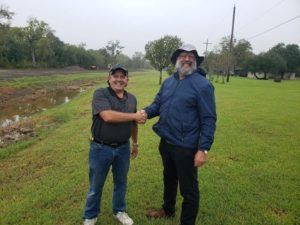After lending a hand in over 10 community science projects, Steven Emerman has some thoughts about what it means to be a scientific partner.

Steven Emerman (right) toured Richwood, Texas, with Kevin McKinney, head of Flood Victims of Richwood, for a project on flooding in 2019.
There was the time he answered lawyers’ questions about flooding for 8 hours in a grueling legal deposition. And the time he helped determine that flood map inputs had been fraudulently altered to pave the way for a sprawling development on a former golf course. And last year, when he crunched numbers from his home in Utah to calculate the probability that James Island, South Carolina, would flood in response to a five-year storm: 100%.
For Steven Emerman, these are happy memories. Emerman, who has a PhD in geophysics from Cornell University and over three decades of experience teaching and studying hydrology, has contributed to more than 10 community science projects with Thriving Earth Exchange. With each project, he finds fresh challenges—and fresh reasons to stay involved.
Learning new things and helping people out
Emerman worked with communities long before Thriving Earth Exchange existed. As a professor at Utah Valley University, he incorporated service learning—projects where students apply their knowledge to address real-world problems in the community—into his classes whenever possible.
“It makes everything way more interesting for the students,” he says. “They learn a lot more if they’re out there doing something rather than sitting and listening to me talk. And they really like it when there’s actually someone who cares about what they’re doing other than their professor.”
Emerman heard about Thriving Earth Exchange shortly before he retired from academia in 2018. At first, it seemed like a good way to expand his network as he started a second career as an independent consultant. Three years later, it’s the experience that keeps him coming back for more. “I like learning new things and helping people out,” he says. “I get to use the skills I have, and learn more in the process.”
Asked to offer advice for other scientists thinking about signing on to a community science project, Emerman pointed to three main lessons.
Lesson #1: It’s not about you
While many scientists find plenty of value in sharing their expertise, community science is about the community, not the scientist. Emerman cautions that researchers should not go into a project as a way of advancing their career.
For starters, in most academic settings working with communities isn’t going to earn you much in the way of career advancement. Even when Emerman’s service learning program was recognized with a statewide award, the Utah Campus Compact Presidential Award – Community Engaged Faculty, the achievement wasn’t seen as valuable by his administration in the same way that a scientific publication or grant would be viewed. “You never got any [career] reward for doing that kind of thing—it didn’t count for getting rehired or getting promoted or getting tenure,” he says.
Mindsets may be shifting in some schools and funding organizations, but that sort of change comes slowly. At a more fundamental level, though, Emerman urges scientists to keep the focus on the community and its needs—not their own research or goals. “If you’re doing a project thinking you’re going to get a publication out of it, that’s problematic,” he says. “You’re not supposed to have your own agenda when you’re helping a community.”
Lesson #2: Know your limits
Emerman doesn’t shy away from what he calls “the rough stuff”—projects that involve legal battles or communities in conflict with big companies. Through experience, he has found that when you have data and sound scientific methods on your side, your work can hold sway against even the most powerful opposition. “I learned not to be frightened by anyone else’s consultants,” he says.
However, conflict can be uncomfortable and even pose risks. “A lot of scientists don’t want to get involved in conflict, especially if it’s something that’s going to go to court,” he says. “I love going to court, giving testimony, giving deposition—but it’s not for everybody.”
As a private consultant, Emerman recognizes that he has the luxury to take risks that others may not be willing to take. He says it’s important to consider the possible outcomes and your own vulnerabilities when assessing whether and how to get involved. “If you’re working with a community that’s contesting somebody like a company or local government, that company or local government will have no qualms about going after race, ethnicity, gender or sexual orientation of the scientist,” Emerman notes. “These conflict situations can be frightening, especially when it’s in your own state and you’re in conflict with people who you might have some other connection with.”
Lesson #3: Focus on your strengths—and keep the community first
As a scientific partner, you’re there to share the expertise you have—not to be an all-purpose adviser. Emerman says it’s common for communities grappling with complex challenges to seek not only scientific analyses but legal advice, political strategy or even medical opinions.
“You have to be careful about getting in the advice business,” he cautions. “I can’t give advice about something I know nothing about.”
Sometimes, it takes a bit of work to pin down exactly what the community wants from the scientist, and to learn to work together as partners. Emerman says it can help to bring in other experts to determine exactly what scientific questions need to be answered in order for the community to take specific actions, like filing a legal brief.
As a scientific partner, your greatest value lies in focusing on what you bring to the table—and then delivering it. And as flood-prone communities across the U.S. can attest, Steven Emerman does exactly that.
Look for stories from other community scientists in our Scientist Spotlights series on the Thriving Earth Exchange blog.

1 Comment
Gloria HorningJun 15, 2021 at 11:34 AM
A BIG THANK from Higherground Pensacola.